Civil Engineering Report: Construction Methods and Solutions
VerifiedAdded on 2020/01/28
|28
|7147
|208
Report
AI Summary
This report, prepared for Balfour Beatty, provides a comprehensive overview of civil engineering construction methods applicable to a river crossing project. It details various techniques for tunnelling, including bored tunnelling, cut and cover, and drill and blast, with a recommendation for the drill and blast method for constructing a new tunnel at the Blackwall Tunnel. The report also covers construction methods for hydraulic structures, proposing modifications to existing flood barriers on the Thames River and discussing the potential for marine structures like wind turbines. Furthermore, it explores construction methods for highways and railway works, including the use of composite methods. The report includes a resource and management plan, offering solutions to complex civil engineering challenges. It also analyzes construction methods for marine structures and designs a flood barrier. The report concludes with findings, recommendations, and a summary of the proposed construction works.
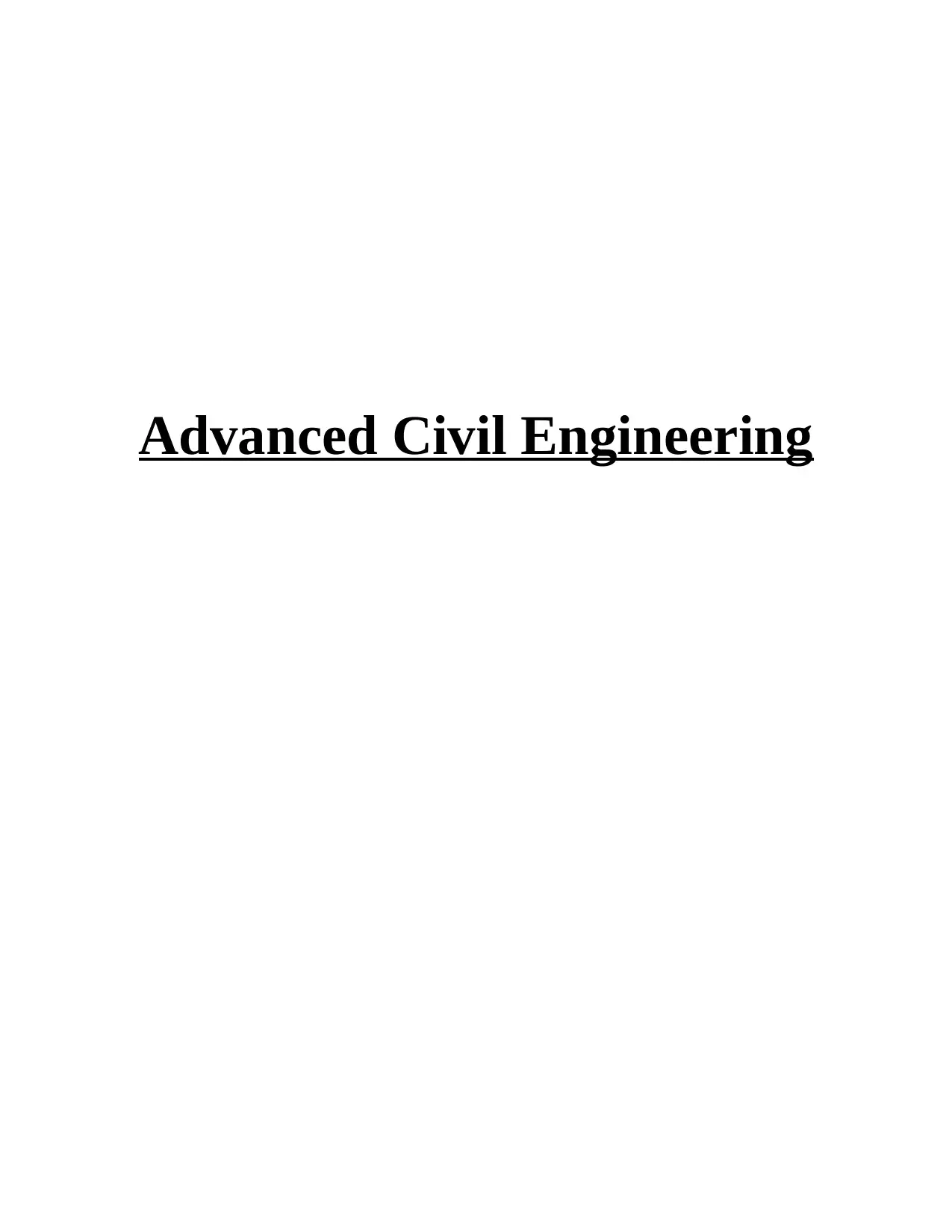
Advanced Civil Engineering
Paraphrase This Document
Need a fresh take? Get an instant paraphrase of this document with our AI Paraphraser
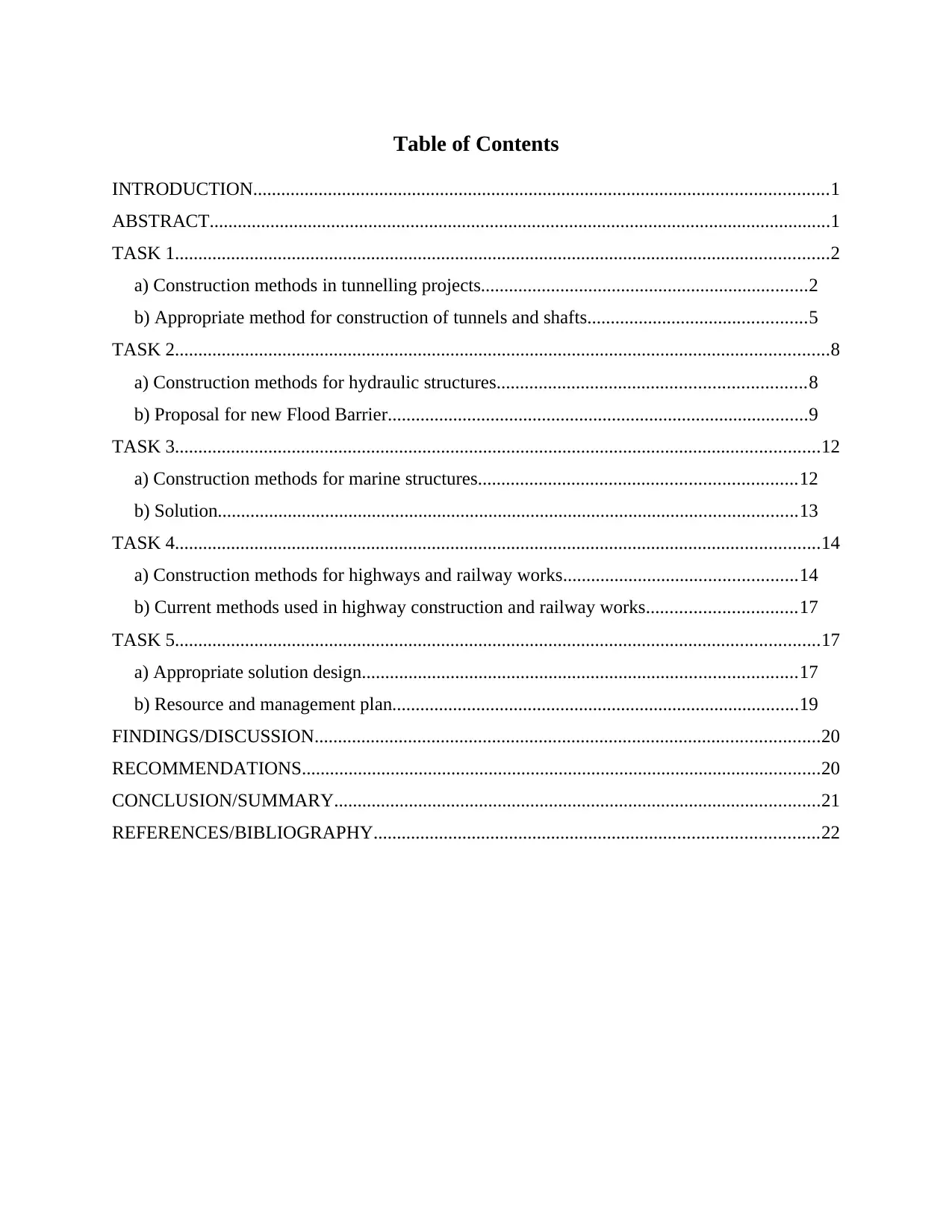
Table of Contents
INTRODUCTION...........................................................................................................................1
ABSTRACT.....................................................................................................................................1
TASK 1............................................................................................................................................2
a) Construction methods in tunnelling projects......................................................................2
b) Appropriate method for construction of tunnels and shafts...............................................5
TASK 2............................................................................................................................................8
a) Construction methods for hydraulic structures..................................................................8
b) Proposal for new Flood Barrier..........................................................................................9
TASK 3..........................................................................................................................................12
a) Construction methods for marine structures....................................................................12
b) Solution............................................................................................................................13
TASK 4..........................................................................................................................................14
a) Construction methods for highways and railway works..................................................14
b) Current methods used in highway construction and railway works................................17
TASK 5..........................................................................................................................................17
a) Appropriate solution design.............................................................................................17
b) Resource and management plan.......................................................................................19
FINDINGS/DISCUSSION............................................................................................................20
RECOMMENDATIONS...............................................................................................................20
CONCLUSION/SUMMARY........................................................................................................21
REFERENCES/BIBLIOGRAPHY...............................................................................................22
INTRODUCTION...........................................................................................................................1
ABSTRACT.....................................................................................................................................1
TASK 1............................................................................................................................................2
a) Construction methods in tunnelling projects......................................................................2
b) Appropriate method for construction of tunnels and shafts...............................................5
TASK 2............................................................................................................................................8
a) Construction methods for hydraulic structures..................................................................8
b) Proposal for new Flood Barrier..........................................................................................9
TASK 3..........................................................................................................................................12
a) Construction methods for marine structures....................................................................12
b) Solution............................................................................................................................13
TASK 4..........................................................................................................................................14
a) Construction methods for highways and railway works..................................................14
b) Current methods used in highway construction and railway works................................17
TASK 5..........................................................................................................................................17
a) Appropriate solution design.............................................................................................17
b) Resource and management plan.......................................................................................19
FINDINGS/DISCUSSION............................................................................................................20
RECOMMENDATIONS...............................................................................................................20
CONCLUSION/SUMMARY........................................................................................................21
REFERENCES/BIBLIOGRAPHY...............................................................................................22
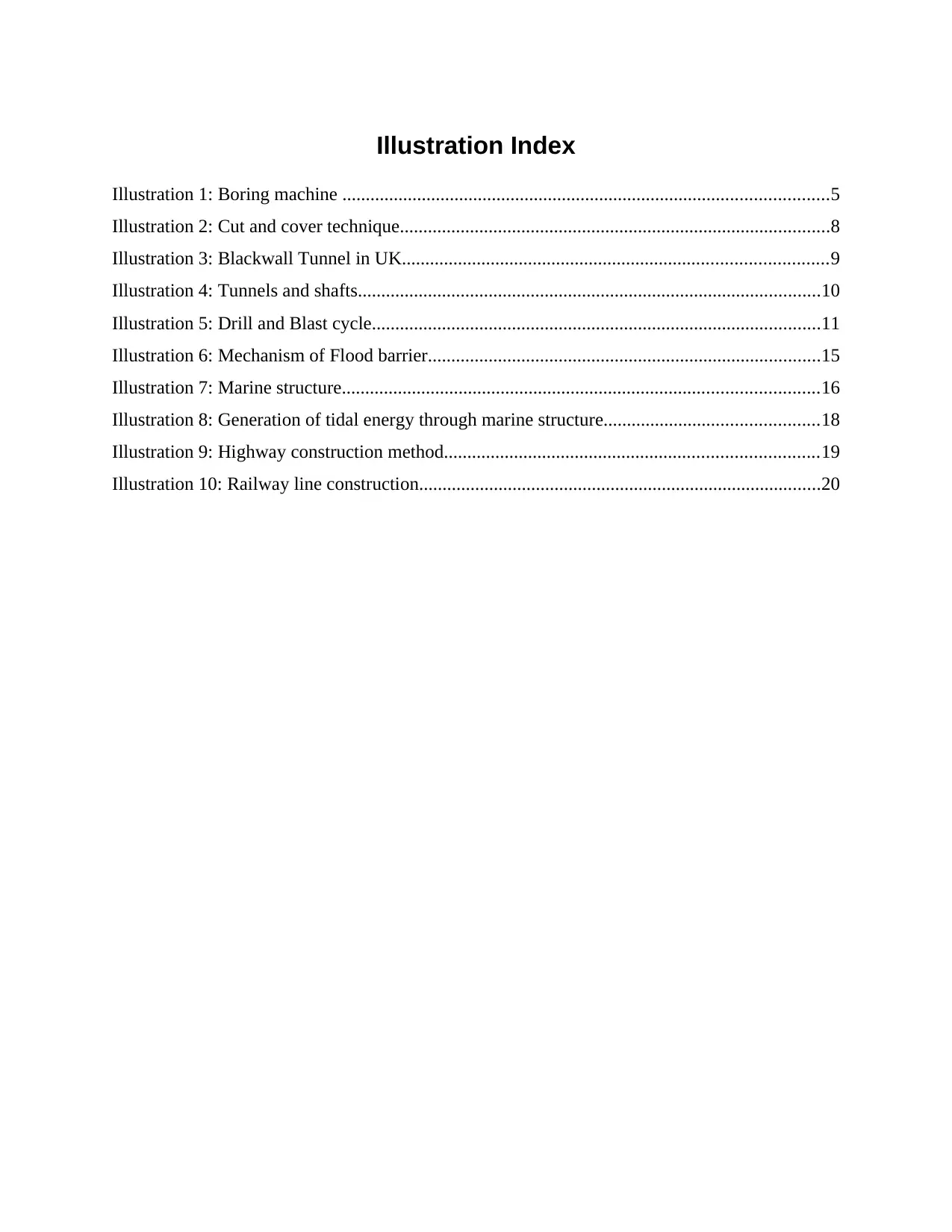
Illustration Index
Illustration 1: Boring machine ........................................................................................................5
Illustration 2: Cut and cover technique............................................................................................8
Illustration 3: Blackwall Tunnel in UK...........................................................................................9
Illustration 4: Tunnels and shafts...................................................................................................10
Illustration 5: Drill and Blast cycle................................................................................................11
Illustration 6: Mechanism of Flood barrier....................................................................................15
Illustration 7: Marine structure......................................................................................................16
Illustration 8: Generation of tidal energy through marine structure..............................................18
Illustration 9: Highway construction method................................................................................19
Illustration 10: Railway line construction......................................................................................20
Illustration 1: Boring machine ........................................................................................................5
Illustration 2: Cut and cover technique............................................................................................8
Illustration 3: Blackwall Tunnel in UK...........................................................................................9
Illustration 4: Tunnels and shafts...................................................................................................10
Illustration 5: Drill and Blast cycle................................................................................................11
Illustration 6: Mechanism of Flood barrier....................................................................................15
Illustration 7: Marine structure......................................................................................................16
Illustration 8: Generation of tidal energy through marine structure..............................................18
Illustration 9: Highway construction method................................................................................19
Illustration 10: Railway line construction......................................................................................20
⊘ This is a preview!⊘
Do you want full access?
Subscribe today to unlock all pages.

Trusted by 1+ million students worldwide
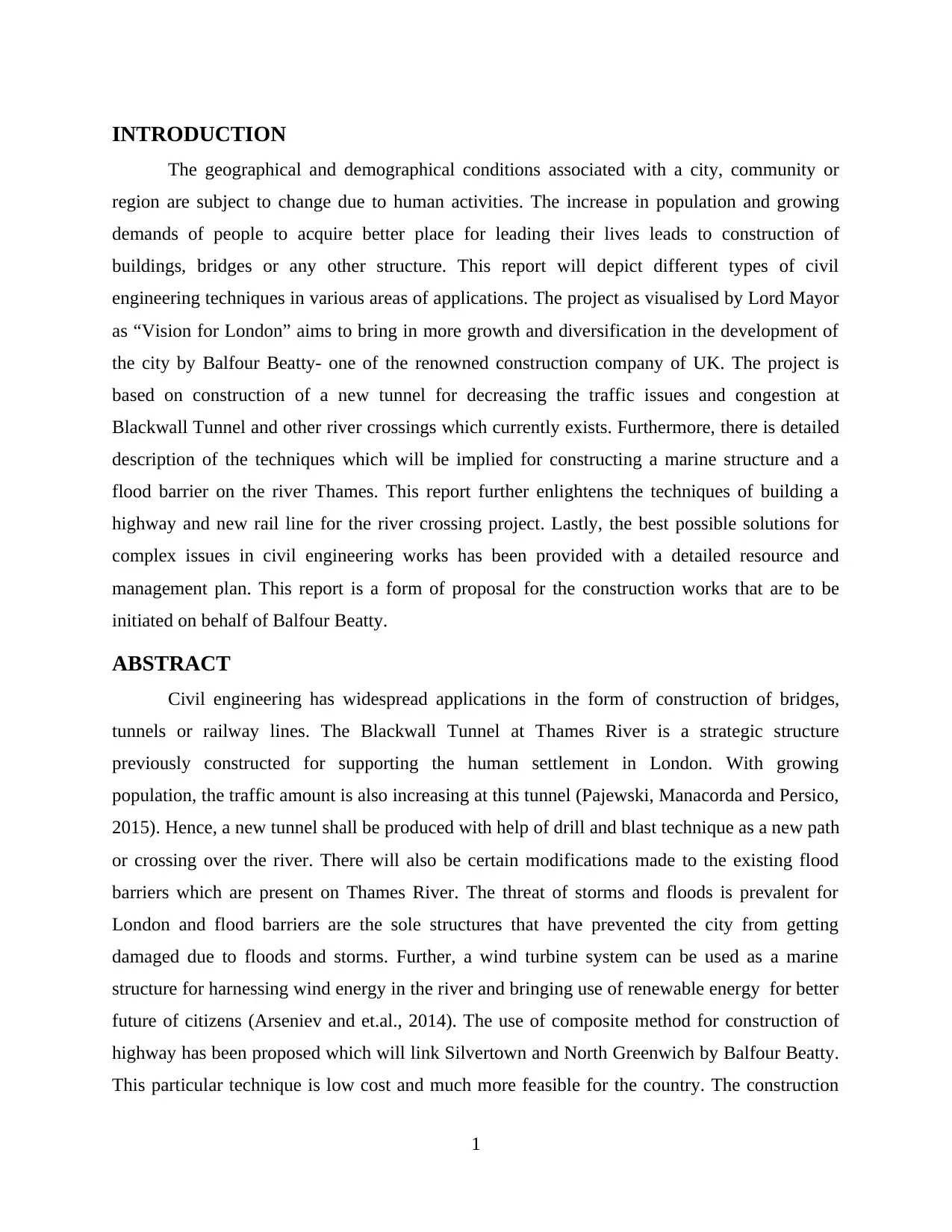
INTRODUCTION
The geographical and demographical conditions associated with a city, community or
region are subject to change due to human activities. The increase in population and growing
demands of people to acquire better place for leading their lives leads to construction of
buildings, bridges or any other structure. This report will depict different types of civil
engineering techniques in various areas of applications. The project as visualised by Lord Mayor
as “Vision for London” aims to bring in more growth and diversification in the development of
the city by Balfour Beatty- one of the renowned construction company of UK. The project is
based on construction of a new tunnel for decreasing the traffic issues and congestion at
Blackwall Tunnel and other river crossings which currently exists. Furthermore, there is detailed
description of the techniques which will be implied for constructing a marine structure and a
flood barrier on the river Thames. This report further enlightens the techniques of building a
highway and new rail line for the river crossing project. Lastly, the best possible solutions for
complex issues in civil engineering works has been provided with a detailed resource and
management plan. This report is a form of proposal for the construction works that are to be
initiated on behalf of Balfour Beatty.
ABSTRACT
Civil engineering has widespread applications in the form of construction of bridges,
tunnels or railway lines. The Blackwall Tunnel at Thames River is a strategic structure
previously constructed for supporting the human settlement in London. With growing
population, the traffic amount is also increasing at this tunnel (Pajewski, Manacorda and Persico,
2015). Hence, a new tunnel shall be produced with help of drill and blast technique as a new path
or crossing over the river. There will also be certain modifications made to the existing flood
barriers which are present on Thames River. The threat of storms and floods is prevalent for
London and flood barriers are the sole structures that have prevented the city from getting
damaged due to floods and storms. Further, a wind turbine system can be used as a marine
structure for harnessing wind energy in the river and bringing use of renewable energy for better
future of citizens (Arseniev and et.al., 2014). The use of composite method for construction of
highway has been proposed which will link Silvertown and North Greenwich by Balfour Beatty.
This particular technique is low cost and much more feasible for the country. The construction
1
The geographical and demographical conditions associated with a city, community or
region are subject to change due to human activities. The increase in population and growing
demands of people to acquire better place for leading their lives leads to construction of
buildings, bridges or any other structure. This report will depict different types of civil
engineering techniques in various areas of applications. The project as visualised by Lord Mayor
as “Vision for London” aims to bring in more growth and diversification in the development of
the city by Balfour Beatty- one of the renowned construction company of UK. The project is
based on construction of a new tunnel for decreasing the traffic issues and congestion at
Blackwall Tunnel and other river crossings which currently exists. Furthermore, there is detailed
description of the techniques which will be implied for constructing a marine structure and a
flood barrier on the river Thames. This report further enlightens the techniques of building a
highway and new rail line for the river crossing project. Lastly, the best possible solutions for
complex issues in civil engineering works has been provided with a detailed resource and
management plan. This report is a form of proposal for the construction works that are to be
initiated on behalf of Balfour Beatty.
ABSTRACT
Civil engineering has widespread applications in the form of construction of bridges,
tunnels or railway lines. The Blackwall Tunnel at Thames River is a strategic structure
previously constructed for supporting the human settlement in London. With growing
population, the traffic amount is also increasing at this tunnel (Pajewski, Manacorda and Persico,
2015). Hence, a new tunnel shall be produced with help of drill and blast technique as a new path
or crossing over the river. There will also be certain modifications made to the existing flood
barriers which are present on Thames River. The threat of storms and floods is prevalent for
London and flood barriers are the sole structures that have prevented the city from getting
damaged due to floods and storms. Further, a wind turbine system can be used as a marine
structure for harnessing wind energy in the river and bringing use of renewable energy for better
future of citizens (Arseniev and et.al., 2014). The use of composite method for construction of
highway has been proposed which will link Silvertown and North Greenwich by Balfour Beatty.
This particular technique is low cost and much more feasible for the country. The construction
1
Paraphrase This Document
Need a fresh take? Get an instant paraphrase of this document with our AI Paraphraser
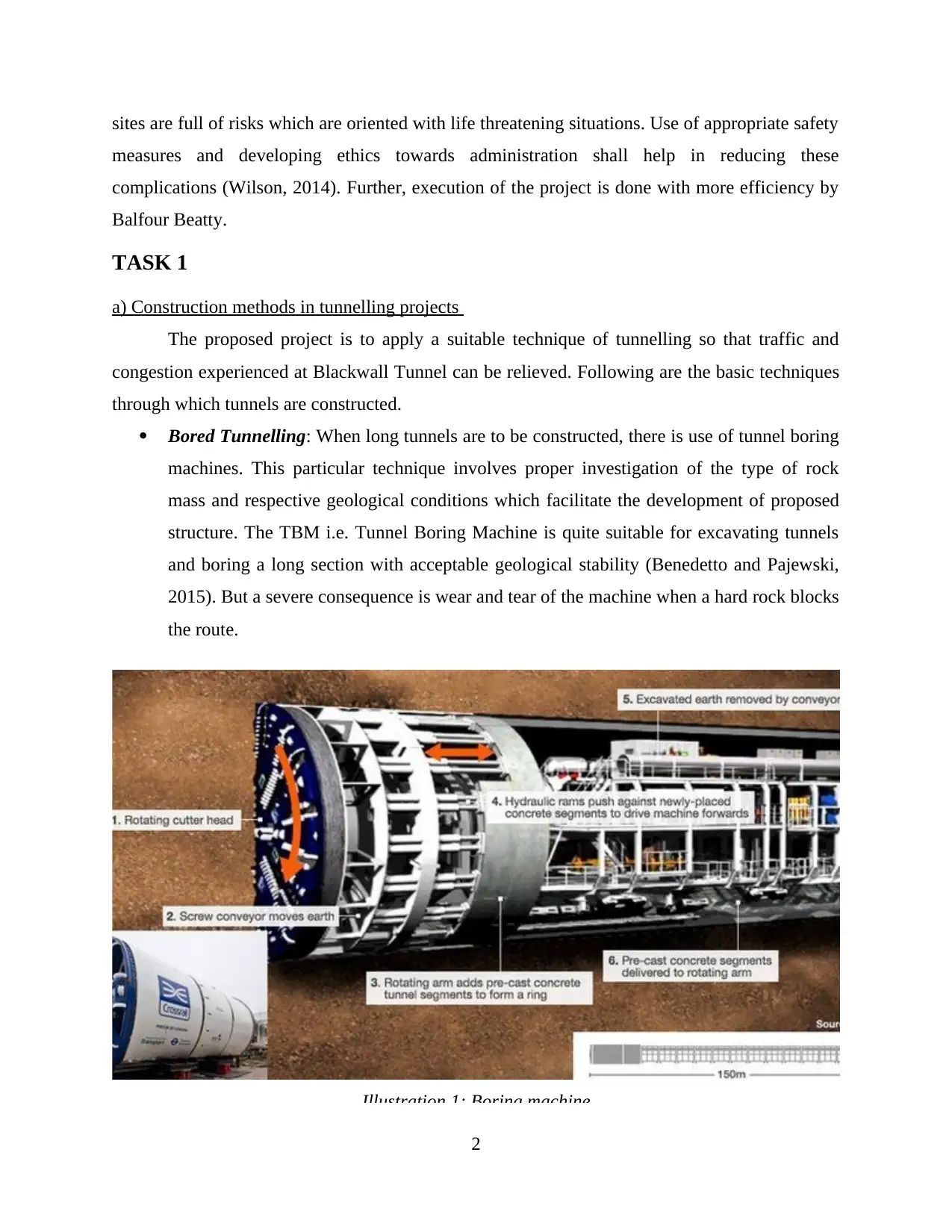
sites are full of risks which are oriented with life threatening situations. Use of appropriate safety
measures and developing ethics towards administration shall help in reducing these
complications (Wilson, 2014). Further, execution of the project is done with more efficiency by
Balfour Beatty.
TASK 1
a) Construction methods in tunnelling projects
The proposed project is to apply a suitable technique of tunnelling so that traffic and
congestion experienced at Blackwall Tunnel can be relieved. Following are the basic techniques
through which tunnels are constructed.
Bored Tunnelling: When long tunnels are to be constructed, there is use of tunnel boring
machines. This particular technique involves proper investigation of the type of rock
mass and respective geological conditions which facilitate the development of proposed
structure. The TBM i.e. Tunnel Boring Machine is quite suitable for excavating tunnels
and boring a long section with acceptable geological stability (Benedetto and Pajewski,
2015). But a severe consequence is wear and tear of the machine when a hard rock blocks
the route.
2
Illustration 1: Boring machine
measures and developing ethics towards administration shall help in reducing these
complications (Wilson, 2014). Further, execution of the project is done with more efficiency by
Balfour Beatty.
TASK 1
a) Construction methods in tunnelling projects
The proposed project is to apply a suitable technique of tunnelling so that traffic and
congestion experienced at Blackwall Tunnel can be relieved. Following are the basic techniques
through which tunnels are constructed.
Bored Tunnelling: When long tunnels are to be constructed, there is use of tunnel boring
machines. This particular technique involves proper investigation of the type of rock
mass and respective geological conditions which facilitate the development of proposed
structure. The TBM i.e. Tunnel Boring Machine is quite suitable for excavating tunnels
and boring a long section with acceptable geological stability (Benedetto and Pajewski,
2015). But a severe consequence is wear and tear of the machine when a hard rock blocks
the route.
2
Illustration 1: Boring machine
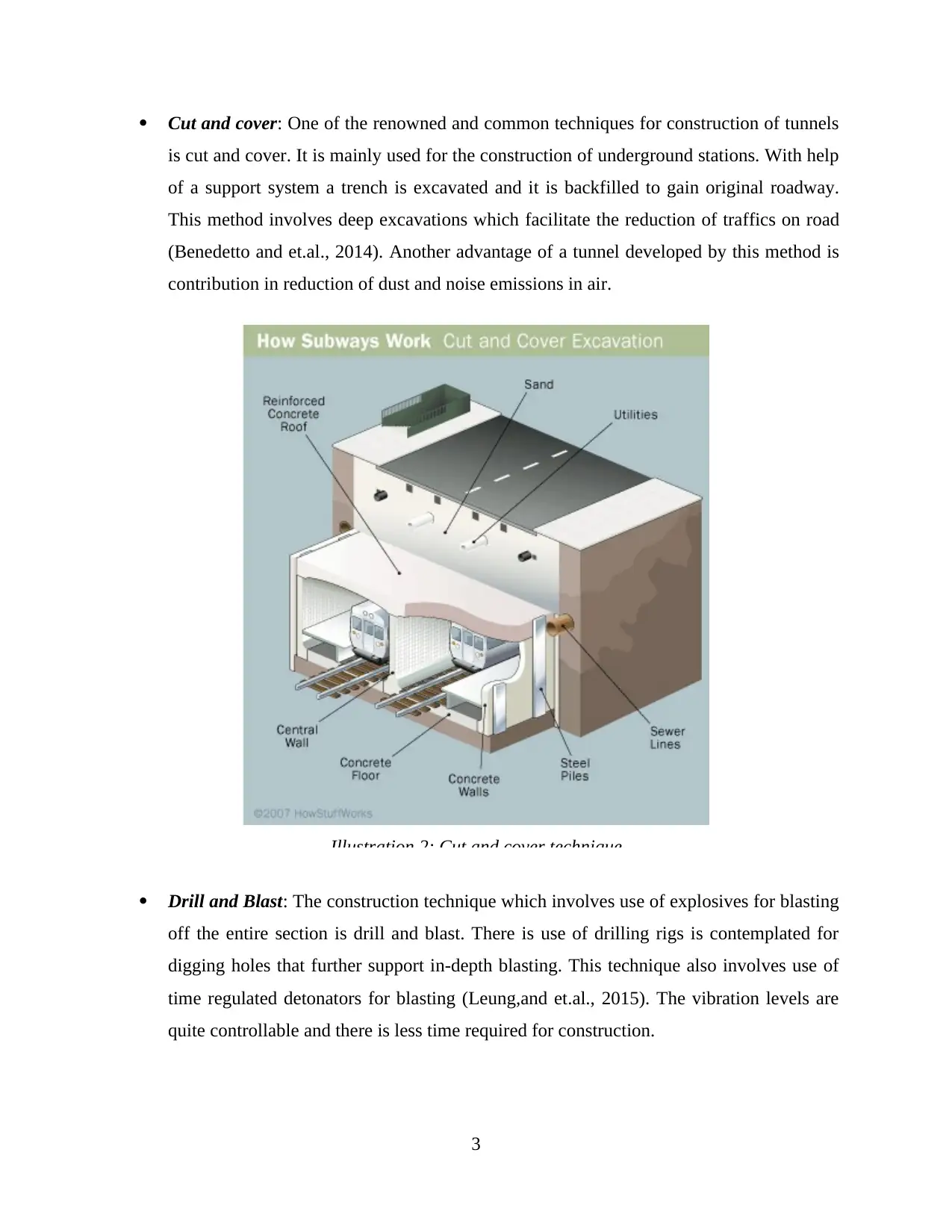
Cut and cover: One of the renowned and common techniques for construction of tunnels
is cut and cover. It is mainly used for the construction of underground stations. With help
of a support system a trench is excavated and it is backfilled to gain original roadway.
This method involves deep excavations which facilitate the reduction of traffics on road
(Benedetto and et.al., 2014). Another advantage of a tunnel developed by this method is
contribution in reduction of dust and noise emissions in air.
Drill and Blast: The construction technique which involves use of explosives for blasting
off the entire section is drill and blast. There is use of drilling rigs is contemplated for
digging holes that further support in-depth blasting. This technique also involves use of
time regulated detonators for blasting (Leung,and et.al., 2015). The vibration levels are
quite controllable and there is less time required for construction.
3
Illustration 2: Cut and cover technique
is cut and cover. It is mainly used for the construction of underground stations. With help
of a support system a trench is excavated and it is backfilled to gain original roadway.
This method involves deep excavations which facilitate the reduction of traffics on road
(Benedetto and et.al., 2014). Another advantage of a tunnel developed by this method is
contribution in reduction of dust and noise emissions in air.
Drill and Blast: The construction technique which involves use of explosives for blasting
off the entire section is drill and blast. There is use of drilling rigs is contemplated for
digging holes that further support in-depth blasting. This technique also involves use of
time regulated detonators for blasting (Leung,and et.al., 2015). The vibration levels are
quite controllable and there is less time required for construction.
3
Illustration 2: Cut and cover technique
⊘ This is a preview!⊘
Do you want full access?
Subscribe today to unlock all pages.

Trusted by 1+ million students worldwide
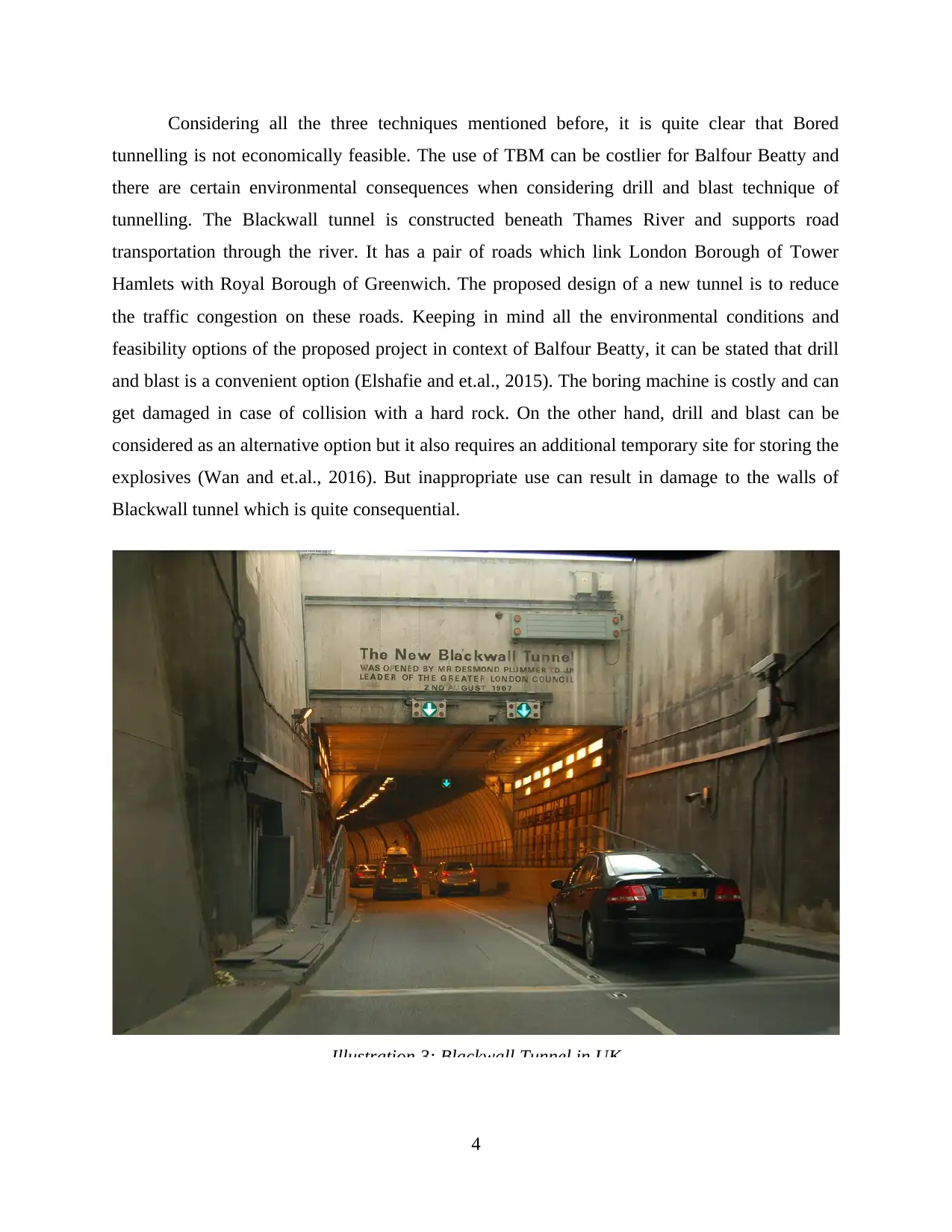
Considering all the three techniques mentioned before, it is quite clear that Bored
tunnelling is not economically feasible. The use of TBM can be costlier for Balfour Beatty and
there are certain environmental consequences when considering drill and blast technique of
tunnelling. The Blackwall tunnel is constructed beneath Thames River and supports road
transportation through the river. It has a pair of roads which link London Borough of Tower
Hamlets with Royal Borough of Greenwich. The proposed design of a new tunnel is to reduce
the traffic congestion on these roads. Keeping in mind all the environmental conditions and
feasibility options of the proposed project in context of Balfour Beatty, it can be stated that drill
and blast is a convenient option (Elshafie and et.al., 2015). The boring machine is costly and can
get damaged in case of collision with a hard rock. On the other hand, drill and blast can be
considered as an alternative option but it also requires an additional temporary site for storing the
explosives (Wan and et.al., 2016). But inappropriate use can result in damage to the walls of
Blackwall tunnel which is quite consequential.
4
Illustration 3: Blackwall Tunnel in UK
tunnelling is not economically feasible. The use of TBM can be costlier for Balfour Beatty and
there are certain environmental consequences when considering drill and blast technique of
tunnelling. The Blackwall tunnel is constructed beneath Thames River and supports road
transportation through the river. It has a pair of roads which link London Borough of Tower
Hamlets with Royal Borough of Greenwich. The proposed design of a new tunnel is to reduce
the traffic congestion on these roads. Keeping in mind all the environmental conditions and
feasibility options of the proposed project in context of Balfour Beatty, it can be stated that drill
and blast is a convenient option (Elshafie and et.al., 2015). The boring machine is costly and can
get damaged in case of collision with a hard rock. On the other hand, drill and blast can be
considered as an alternative option but it also requires an additional temporary site for storing the
explosives (Wan and et.al., 2016). But inappropriate use can result in damage to the walls of
Blackwall tunnel which is quite consequential.
4
Illustration 3: Blackwall Tunnel in UK
Paraphrase This Document
Need a fresh take? Get an instant paraphrase of this document with our AI Paraphraser
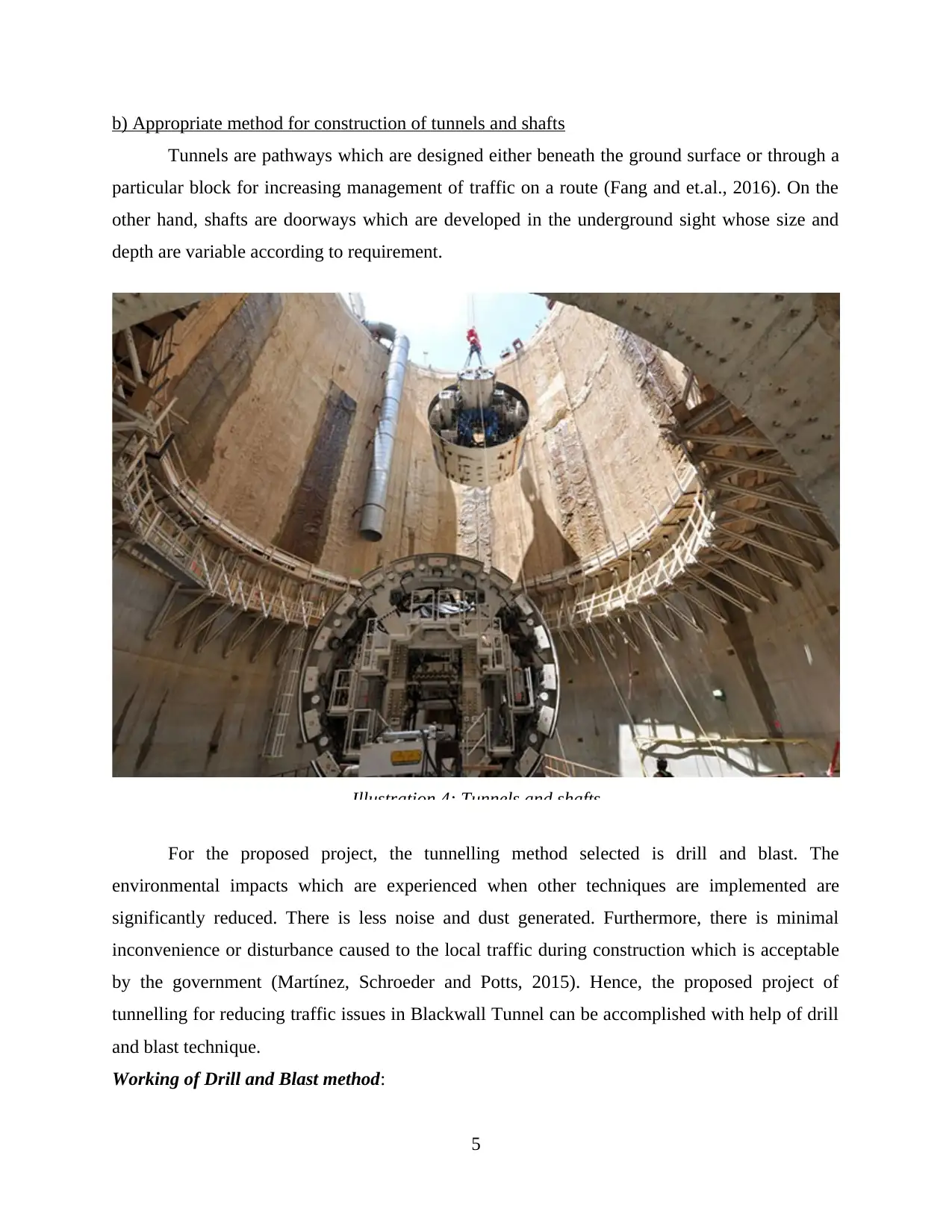
b) Appropriate method for construction of tunnels and shafts
Tunnels are pathways which are designed either beneath the ground surface or through a
particular block for increasing management of traffic on a route (Fang and et.al., 2016). On the
other hand, shafts are doorways which are developed in the underground sight whose size and
depth are variable according to requirement.
For the proposed project, the tunnelling method selected is drill and blast. The
environmental impacts which are experienced when other techniques are implemented are
significantly reduced. There is less noise and dust generated. Furthermore, there is minimal
inconvenience or disturbance caused to the local traffic during construction which is acceptable
by the government (Martínez, Schroeder and Potts, 2015). Hence, the proposed project of
tunnelling for reducing traffic issues in Blackwall Tunnel can be accomplished with help of drill
and blast technique.
Working of Drill and Blast method:
5
Illustration 4: Tunnels and shafts
Tunnels are pathways which are designed either beneath the ground surface or through a
particular block for increasing management of traffic on a route (Fang and et.al., 2016). On the
other hand, shafts are doorways which are developed in the underground sight whose size and
depth are variable according to requirement.
For the proposed project, the tunnelling method selected is drill and blast. The
environmental impacts which are experienced when other techniques are implemented are
significantly reduced. There is less noise and dust generated. Furthermore, there is minimal
inconvenience or disturbance caused to the local traffic during construction which is acceptable
by the government (Martínez, Schroeder and Potts, 2015). Hence, the proposed project of
tunnelling for reducing traffic issues in Blackwall Tunnel can be accomplished with help of drill
and blast technique.
Working of Drill and Blast method:
5
Illustration 4: Tunnels and shafts
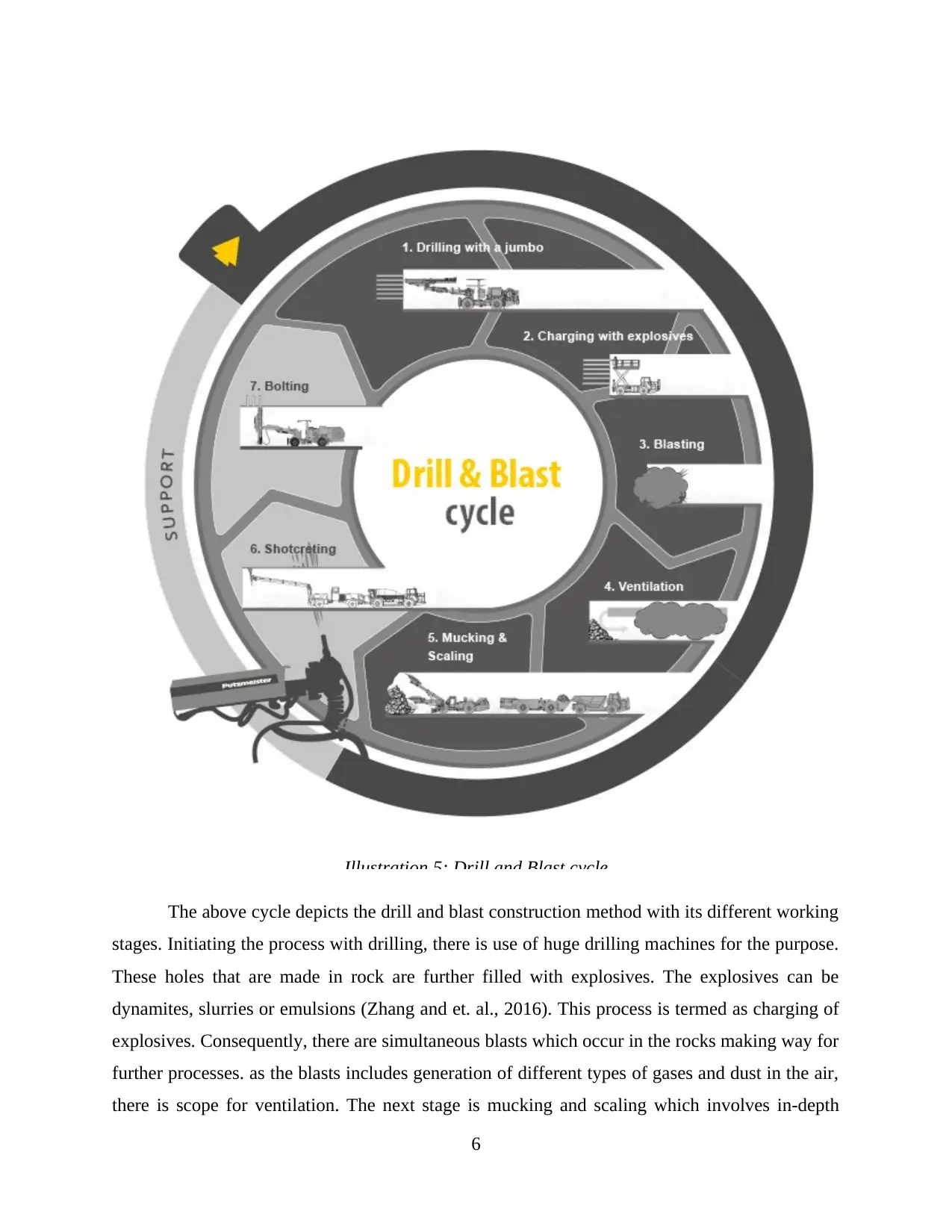
The above cycle depicts the drill and blast construction method with its different working
stages. Initiating the process with drilling, there is use of huge drilling machines for the purpose.
These holes that are made in rock are further filled with explosives. The explosives can be
dynamites, slurries or emulsions (Zhang and et. al., 2016). This process is termed as charging of
explosives. Consequently, there are simultaneous blasts which occur in the rocks making way for
further processes. as the blasts includes generation of different types of gases and dust in the air,
there is scope for ventilation. The next stage is mucking and scaling which involves in-depth
6
Illustration 5: Drill and Blast cycle
stages. Initiating the process with drilling, there is use of huge drilling machines for the purpose.
These holes that are made in rock are further filled with explosives. The explosives can be
dynamites, slurries or emulsions (Zhang and et. al., 2016). This process is termed as charging of
explosives. Consequently, there are simultaneous blasts which occur in the rocks making way for
further processes. as the blasts includes generation of different types of gases and dust in the air,
there is scope for ventilation. The next stage is mucking and scaling which involves in-depth
6
Illustration 5: Drill and Blast cycle
⊘ This is a preview!⊘
Do you want full access?
Subscribe today to unlock all pages.

Trusted by 1+ million students worldwide
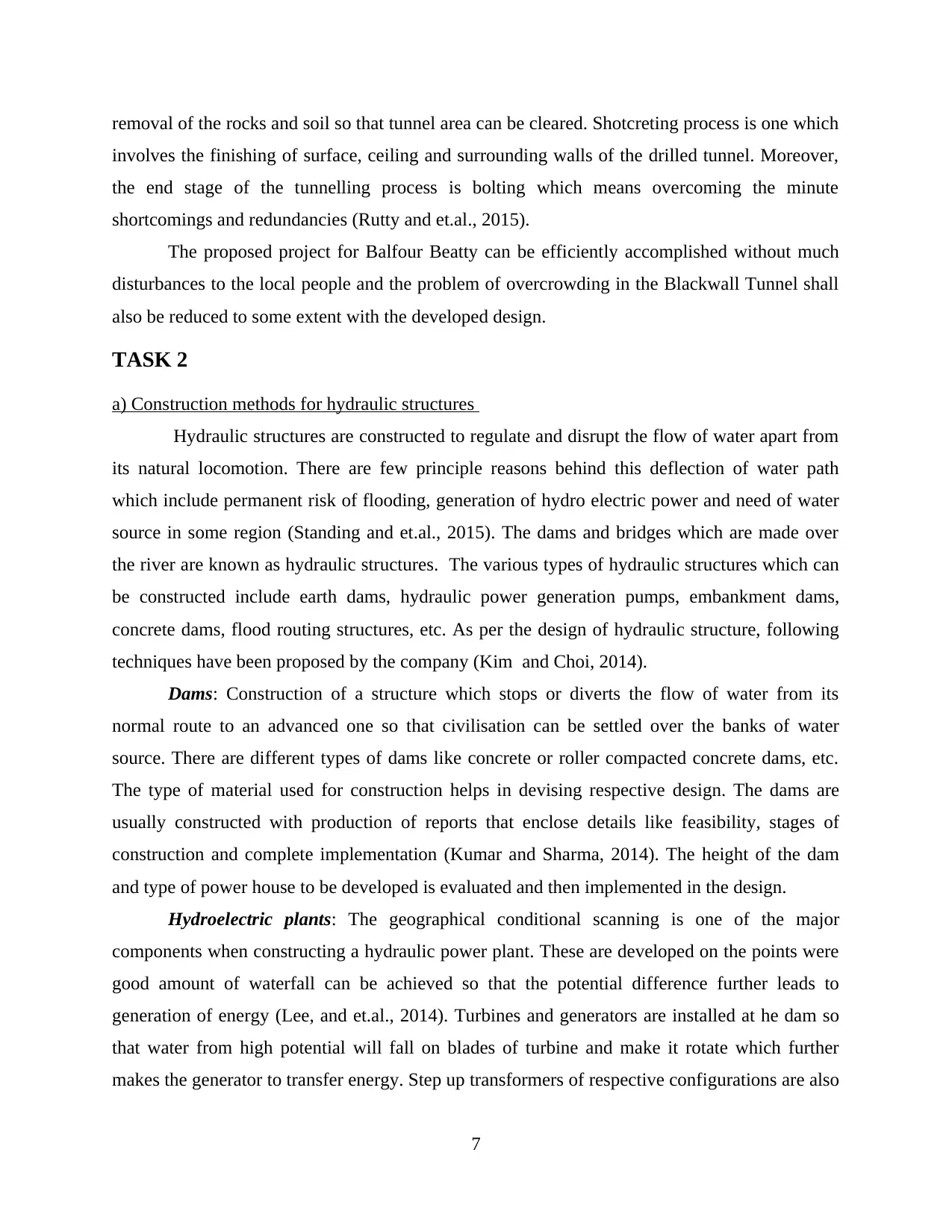
removal of the rocks and soil so that tunnel area can be cleared. Shotcreting process is one which
involves the finishing of surface, ceiling and surrounding walls of the drilled tunnel. Moreover,
the end stage of the tunnelling process is bolting which means overcoming the minute
shortcomings and redundancies (Rutty and et.al., 2015).
The proposed project for Balfour Beatty can be efficiently accomplished without much
disturbances to the local people and the problem of overcrowding in the Blackwall Tunnel shall
also be reduced to some extent with the developed design.
TASK 2
a) Construction methods for hydraulic structures
Hydraulic structures are constructed to regulate and disrupt the flow of water apart from
its natural locomotion. There are few principle reasons behind this deflection of water path
which include permanent risk of flooding, generation of hydro electric power and need of water
source in some region (Standing and et.al., 2015). The dams and bridges which are made over
the river are known as hydraulic structures. The various types of hydraulic structures which can
be constructed include earth dams, hydraulic power generation pumps, embankment dams,
concrete dams, flood routing structures, etc. As per the design of hydraulic structure, following
techniques have been proposed by the company (Kim and Choi, 2014).
Dams: Construction of a structure which stops or diverts the flow of water from its
normal route to an advanced one so that civilisation can be settled over the banks of water
source. There are different types of dams like concrete or roller compacted concrete dams, etc.
The type of material used for construction helps in devising respective design. The dams are
usually constructed with production of reports that enclose details like feasibility, stages of
construction and complete implementation (Kumar and Sharma, 2014). The height of the dam
and type of power house to be developed is evaluated and then implemented in the design.
Hydroelectric plants: The geographical conditional scanning is one of the major
components when constructing a hydraulic power plant. These are developed on the points were
good amount of waterfall can be achieved so that the potential difference further leads to
generation of energy (Lee, and et.al., 2014). Turbines and generators are installed at he dam so
that water from high potential will fall on blades of turbine and make it rotate which further
makes the generator to transfer energy. Step up transformers of respective configurations are also
7
involves the finishing of surface, ceiling and surrounding walls of the drilled tunnel. Moreover,
the end stage of the tunnelling process is bolting which means overcoming the minute
shortcomings and redundancies (Rutty and et.al., 2015).
The proposed project for Balfour Beatty can be efficiently accomplished without much
disturbances to the local people and the problem of overcrowding in the Blackwall Tunnel shall
also be reduced to some extent with the developed design.
TASK 2
a) Construction methods for hydraulic structures
Hydraulic structures are constructed to regulate and disrupt the flow of water apart from
its natural locomotion. There are few principle reasons behind this deflection of water path
which include permanent risk of flooding, generation of hydro electric power and need of water
source in some region (Standing and et.al., 2015). The dams and bridges which are made over
the river are known as hydraulic structures. The various types of hydraulic structures which can
be constructed include earth dams, hydraulic power generation pumps, embankment dams,
concrete dams, flood routing structures, etc. As per the design of hydraulic structure, following
techniques have been proposed by the company (Kim and Choi, 2014).
Dams: Construction of a structure which stops or diverts the flow of water from its
normal route to an advanced one so that civilisation can be settled over the banks of water
source. There are different types of dams like concrete or roller compacted concrete dams, etc.
The type of material used for construction helps in devising respective design. The dams are
usually constructed with production of reports that enclose details like feasibility, stages of
construction and complete implementation (Kumar and Sharma, 2014). The height of the dam
and type of power house to be developed is evaluated and then implemented in the design.
Hydroelectric plants: The geographical conditional scanning is one of the major
components when constructing a hydraulic power plant. These are developed on the points were
good amount of waterfall can be achieved so that the potential difference further leads to
generation of energy (Lee, and et.al., 2014). Turbines and generators are installed at he dam so
that water from high potential will fall on blades of turbine and make it rotate which further
makes the generator to transfer energy. Step up transformers of respective configurations are also
7
Paraphrase This Document
Need a fresh take? Get an instant paraphrase of this document with our AI Paraphraser

added for enlarging the voltage. This particular construction varies only in the type of
equipments applied and the nature of dam being used.
Flood Barriers: Flood barriers have significant place in designing of hydraulic power
plant. These barriers prevent from storm surge and help in preventing are which is behind the
barrier (Abdullaev and Rakhmatullaev, 2015.). The flood barrier operates only when needed
because it have feature of stop log. Automatic flood barriers operates self whenever there is a
condition of rising flood . Thames is also having flood barrier which is protecting from storm
surges and major tides. Flood barrier at Thames is one of the largest barriers in the world. In
construction of hydraulic plant it is one to major concerning point . Flood barriers consist of food
walls, levees and various other natural and geographical attributes (Ahmed, McLoughlin and
Johnston, 2014). In case of high tides and larger storm it can restore flow which goes towards
sea. These barriers can be placed around sites which are prone to storm and tides. Flood barriers
help in preventing floods to enter in building . Flood barrier has been installed in the river
Thames to protect tunnel and river bridge from storms.
b) Proposal for new Flood Barrier
The Thames Flood Barrier is a type of movable flood barrier and is operational from
1984. The purpose behind development of this barrier was to reduce the frequency of flooding
and risks of the same due to high tides. It has circular rotating gates which are raised for allowing
under-spilling of water so that upstream levels can be controlled. These are made of steel with 40
millimetres thickness. The closure of gates takes place when there is forecast of high tides in
North Sea. The advantage of this flood barrier is that it notifies about 9 hours before the high tide
could reach the city (Descloux and et. al., 2015). This depicts that there is enough time for taking
necessary precautionary measures.
8
equipments applied and the nature of dam being used.
Flood Barriers: Flood barriers have significant place in designing of hydraulic power
plant. These barriers prevent from storm surge and help in preventing are which is behind the
barrier (Abdullaev and Rakhmatullaev, 2015.). The flood barrier operates only when needed
because it have feature of stop log. Automatic flood barriers operates self whenever there is a
condition of rising flood . Thames is also having flood barrier which is protecting from storm
surges and major tides. Flood barrier at Thames is one of the largest barriers in the world. In
construction of hydraulic plant it is one to major concerning point . Flood barriers consist of food
walls, levees and various other natural and geographical attributes (Ahmed, McLoughlin and
Johnston, 2014). In case of high tides and larger storm it can restore flow which goes towards
sea. These barriers can be placed around sites which are prone to storm and tides. Flood barriers
help in preventing floods to enter in building . Flood barrier has been installed in the river
Thames to protect tunnel and river bridge from storms.
b) Proposal for new Flood Barrier
The Thames Flood Barrier is a type of movable flood barrier and is operational from
1984. The purpose behind development of this barrier was to reduce the frequency of flooding
and risks of the same due to high tides. It has circular rotating gates which are raised for allowing
under-spilling of water so that upstream levels can be controlled. These are made of steel with 40
millimetres thickness. The closure of gates takes place when there is forecast of high tides in
North Sea. The advantage of this flood barrier is that it notifies about 9 hours before the high tide
could reach the city (Descloux and et. al., 2015). This depicts that there is enough time for taking
necessary precautionary measures.
8
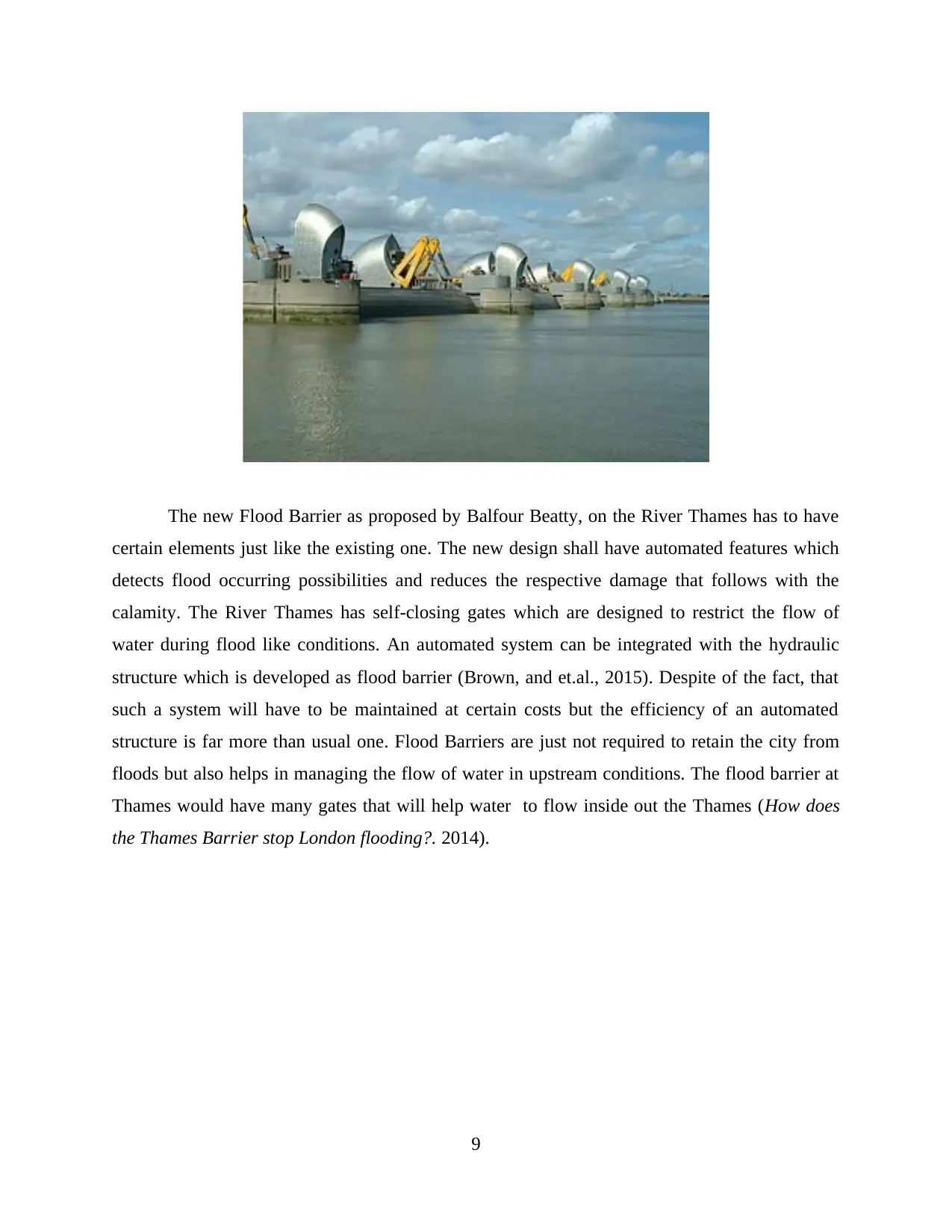
The new Flood Barrier as proposed by Balfour Beatty, on the River Thames has to have
certain elements just like the existing one. The new design shall have automated features which
detects flood occurring possibilities and reduces the respective damage that follows with the
calamity. The River Thames has self-closing gates which are designed to restrict the flow of
water during flood like conditions. An automated system can be integrated with the hydraulic
structure which is developed as flood barrier (Brown, and et.al., 2015). Despite of the fact, that
such a system will have to be maintained at certain costs but the efficiency of an automated
structure is far more than usual one. Flood Barriers are just not required to retain the city from
floods but also helps in managing the flow of water in upstream conditions. The flood barrier at
Thames would have many gates that will help water to flow inside out the Thames (How does
the Thames Barrier stop London flooding?. 2014).
9
certain elements just like the existing one. The new design shall have automated features which
detects flood occurring possibilities and reduces the respective damage that follows with the
calamity. The River Thames has self-closing gates which are designed to restrict the flow of
water during flood like conditions. An automated system can be integrated with the hydraulic
structure which is developed as flood barrier (Brown, and et.al., 2015). Despite of the fact, that
such a system will have to be maintained at certain costs but the efficiency of an automated
structure is far more than usual one. Flood Barriers are just not required to retain the city from
floods but also helps in managing the flow of water in upstream conditions. The flood barrier at
Thames would have many gates that will help water to flow inside out the Thames (How does
the Thames Barrier stop London flooding?. 2014).
9
⊘ This is a preview!⊘
Do you want full access?
Subscribe today to unlock all pages.

Trusted by 1+ million students worldwide
1 out of 28
Your All-in-One AI-Powered Toolkit for Academic Success.
+13062052269
info@desklib.com
Available 24*7 on WhatsApp / Email
![[object Object]](/_next/static/media/star-bottom.7253800d.svg)
Unlock your academic potential
Copyright © 2020–2025 A2Z Services. All Rights Reserved. Developed and managed by ZUCOL.

